Welcome back to Living Ink, an ongoing series that explores the four-color lands of comic book fantasy that inspire Vs. System. Each week, I examine a character that features in the current expansion and discuss his or her comic book history and powers.
In the 1995 film Mallrats, comic book icon Stan Lee said, “The Hulk: a normal guy one minute, a rage of emotions the next . . . just like me.”
I think it’s fair to say that there’s a little Hulk in all of us (especially while driving in heavy traffic). True to my career as a journalist and writer, I usually fit the cliche of “mild-mannered reporter,” but stress still gets the best of me at times. I like to say that I have a long fuse, but I’m a big bomb—it takes a lot to rile me up, but I’m pretty explosive once I fly off the handle. It’s at this point that my inner Hulk takes over.
As unfair as it is, often the person who bears the worst of my wrath is not the person who really ticked me off in the first place. My eyes feel too big for their sockets, my pulse can be heard pounding in my ears, and rationality goes straight out the window as the camel opens a six-pack of whoopings on the straw that broke its back.
I just wish that whenever I acted like a jerk, especially toward my wife, I could say, “Sorry, I just turned into the Hulk for a few minutes there . . . it wasn’t really me.” It’d also be neat to have such an effective visual indicator of mood. Anyone who sees me and notes that I’m big, green, and excessively muscular would also know that I’m not in a civil mood and could thereby take action to avoid me.
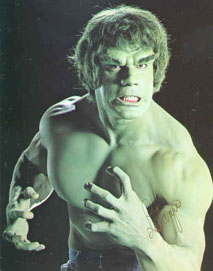 The Hulk is one of the most recognizable comic book characters in existence and remains an iconic character in Western popular culture. Personally, I grew up watching Bill Bixby and Lou Ferrigno portray the dual natures of the Incredible Hulk in the 1978–1982 television series of the same name. I think that as a child, I could really relate to how the Hulk was ruled completely by his emotions; children are not renowned for their self-control, and I was no exception.
The Hulk is one of the most recognizable comic book characters in existence and remains an iconic character in Western popular culture. Personally, I grew up watching Bill Bixby and Lou Ferrigno portray the dual natures of the Incredible Hulk in the 1978–1982 television series of the same name. I think that as a child, I could really relate to how the Hulk was ruled completely by his emotions; children are not renowned for their self-control, and I was no exception.
Thematically, the Hulk’s transformations bring to mind the classic tale of the Strange Case of Dr. Jekyll and Mr. Hyde, written by Robert Louis Stevenson in 1886. At the heart of this novella is the issue of humanity’s inner conflict between its senses of good and evil. As we will soon see, the Hulk is rarely the immoral psychopath that Edward Hyde was, but themes of inner conflict are central to his mythos.
The Hulk was created by Stan Lee and Jack Kirby, and first appeared in Incredible Hulk #1, published in May 1962.
An interesting bit of trivia is the fact that in his first appearance, the Hulk did not have his trademark green skin; he was originally gray in color. But from issue #2 onward—due to green being easier to print consistently—the Hulk took on his emerald hue.
His series was cancelled after only six issues, but it became apparent soon after that the character had found an audience in college-aged readers. The Hulk proved a popular guest-star in three issues of Fantastic Four and an issue of The Amazing Spider-Man, and was then included as a founding member of the Avengers (see Earth’s Mightiest Heroes).
The Hulk regained a solo feature in Tales to Astonish, beginning with issue #60 published in 1964. This title was renamed Incredible Hulk with issue #102 and continued until March 1999, when it was restarted with a new #1.
The Hulk is the alter ego of Dr. Robert Bruce Banner (known to family and friends simply as Bruce). Banner is a scientific genius, specializing in the field of nuclear physics. In the course of conducting an experiment involving gamma radiation, our hero was accidentally exposed to a massive dose of that radiation (see Gamma Bomb), which transformed him into a super strong, misanthropic, green-skinned giant. While often referred to as a super hero, in truth the Hulk is usually more of a menace than a hero because his enraged, mindless rampages usually result in extraordinary collateral damage (see One-Man Rampage).
In addition to super strength, the Hulk is also able to leap several miles at a time. He has been seen leaping a distance of 1,000 miles in a single bound and has even leapt into a low Earth orbit.
The Hulk also has a healing factor, as well as extremely high levels of super-human stamina and resistance to physical injury. He has withstood the impact of high-caliber artillery shells, falls from extraordinary heights, and powerful energy blasts without sustaining injury. Similarly, extreme temperatures, poisons, and diseases are of no consequence to him. This resistance to physical injury and the efficiency of his healing powers fluctuate with his emotional state, though, similar to his physical strength.
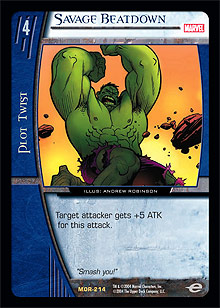 The Hulk’s status as an out-of-control engine of destruction doesn’t make him very popular with the government and the general public. As a result, he has been regularly hunted and hounded by the military and other super heroes, such as Wolverine, who made his first appearance in Incredible Hulk Vol. 1 #180–181 published in 1974. Possessing the mental capacity and temperament of a young child and typically referring to himself in the third person, the Hulk’s primary instinct during these encounters is to escape so that he can be left alone, all the while lashing out with increasing levels of violence (see Savage Beatdown).
The Hulk’s status as an out-of-control engine of destruction doesn’t make him very popular with the government and the general public. As a result, he has been regularly hunted and hounded by the military and other super heroes, such as Wolverine, who made his first appearance in Incredible Hulk Vol. 1 #180–181 published in 1974. Possessing the mental capacity and temperament of a young child and typically referring to himself in the third person, the Hulk’s primary instinct during these encounters is to escape so that he can be left alone, all the while lashing out with increasing levels of violence (see Savage Beatdown).
In early stories, Bruce became the Hulk at sunset each day, but the longest-standing and best-known trigger for his transformations is simply emotional stress. Exposure to radiation or other factors can also bring on the change.
Similar to the Jekyll and Hyde relationship, the Hulk was initially characterized as a separate entity from Dr. Banner, with his own personality and memories separate from the mild-mannered scientist. Over the past few decades, though, writers such as Peter David (who wrote the title continuously for nearly twelve years) have established that Bruce suffers from a form of multiple personality disorder that came as a result of childhood abuse at the hands of his father. The Hulk has many unique personas that have manifested over the years, each representing a different aspect of Banner’s psyche.
In addition to the base personality of Dr. Bruce Banner, the Hulk’s most recognizable persona is the classic Savage Hulk. Essentially the version we have seen in the television and film incarnations of the character, the Savage Hulk is typified by a grotesquely over-sized and muscular frame and possesses only a very basic, almost bestial intelligence. The Savage Hulk is impulsive, violent, and super-strong. Since the angrier Hulk gets the stronger Hulk gets, his strength is theoretically limitless. With this in mind and considering that the Savage Hulk is undeniably the most volatile version of the character, he is almost definitely the strongest incarnation.
The Gray Hulk appeared in later stories and should not be confused with the Hulk in his first appearance (as reprints and retellings of his origin present him with green skin from the very beginning). The Gray Hulk sometimes goes by the name Joe Fixit and worked for a period of time as a shifty Las Vegas enforcer. He is much more intelligent than the Savage Hulk (although probably not as intelligent as Dr. Banner), and could most accurately be described as cunning. He is also hedonistic, arrogant, and seemingly immoral. Joe Fixit is the smallest of the Hulks, and as such is arguably the weakest physically, but he is still much larger and stronger than the average human. The Gray Hulk’s sneakier nature means he is no less dangerous in combat, though.
Another incarnation of the Hulk was once referred to as the Merged Hulk. The personalities of Banner, the Savage Hulk, and the Gray Hulk were merged in Incredible Hulk Vol. 1 #377 to create a single entity. The Merged Hulk later became known as the Professor, and it was ret-conned that this Hulk was actually a unique, fourth incarnation of the character, rather than a merger of the other three. The Professor is believed to be Banner’s ideal self. He looks less bestial than other incarnations, with a straight back and a face that more closely resembles Banner’s normal facial features. Being smarter than the other Hulks means that the Professor is not really prone to excessive rage, and he is therefore not as powerful as the Savage Hulk.
Other versions of the Hulk have been presented in the comic books, but none of these have had the same amount of exposure or—arguably—the impact of the four main personas.
In a defining Hulk storyline, fans were introduced to the Maestro in Hulk: Future Imperfect #1 (1992). The Maestro is actually the Hulk from an alternate future, approximately 100 years from present day. Possessing Banner’s brilliant intellect, as well as the more malevolent aspects of the Hulk’s other personalities, the Maestro can only be described as villainous. After a nuclear war decimated Earth’s human and super-human populations, he established himself as the despotic ruler of a mega-city called Dystopia. Gray-haired, bearded, and balding, the older Hulk grew even stronger via the ambient radiation he absorbed since the war. A group of rebels opposing the Maestro, led by an elderly Rick Jones, bring the Professor Hulk from the past to aid their cause. Unfortunately, the Hulk was unable to beat the stronger, more experienced Maestro, who broke his younger self’s neck (which is something short of a fatal blow for the regenerating Hulk) and then tried to convince his opponent that nothing he did could change the course of time and that he would continue to be persecuted in his present.
Once the Hulk recovered, he confronted the Maestro again. He was overpowered once more, but the fight provided the rebels the opportunity to use their time machine to send the despot back in time to the place where the Hulk was first created. Being at ground zero during the Gamma Bomb explosion was believed to be the only thing that could kill the Maestro.
The Maestro returned one last time, but in a weakened state. The Hulk defeated him this time, and the Maestro appeared to die yet again.
“Planet Hulk” is the most recent Hulk storyline, commencing last year and continuing now. The secret super hero organization known as The Illuminati decided to take definitive action against the destructive Hulk. They trapped the Grumpy Green Goliath, bundled him into a rocket, and shot him into space, destined for an uninhabited planet. But a malfunction resulted in the Hulk’s ship travelling through a wormhole and crash landing on the planet Sakaar, a world dominated by a violent and war-like culture. A weakened Hulk was sold into slavery and ended up fighting for his life as a gladiator. He overcame his poor fortunes to become the world’s greatest gladiator, a rebel leader, and ultimately a conqueror. I’m waiting for this storyline to be collected as a trade paperback in June, but a couple of friends who are Hulk fans have raved about it.
In Vs. System, the Hulk has been represented on five character cards to date.
Hulk, Grumpy Green Goliath is one of the more recent Vs. System versions of the character, and is featured in the Marvel Team-Up expansion. Reinforcing the well-known fact that the Hulk is one strong hombre, the smallest version of the character in Vs. System is a 5-drop! As we’ve already heard, the madder Hulk gets, the stronger Hulk gets. Whenever this Hulk exhausts—which happens every time he attacks—he gets a bit bigger. This is a wonderful way to represent a fundamental aspect of Hulk’s comic book character. The artwork on this card shows Hulk looking somewhat at peace, calmly enjoying nature. I really dig that, as it supports the theory that if everyone just left him alone, the Hulk wouldn’t be such a destructive force.
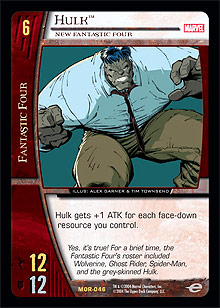
Hulk, New Fantastic Four was the first Vs. System Hulk ever, appearing as a Fantastic Four 6-drop in Marvel Origins. Like Spider-Man, New Fantastic Four, which we looked at in the first ever Living Ink, this card specifically references a storyline featured in Fantastic Four #347-349, published from December 1990 to February 1991. In it, the Hulk, Spidey, Wolverine, and Ghost Rider formed a new Fantastic Four after being tricked into thinking the originals were dead. His power makes him potentially the strongest 6-drop in the game in terms of ATK, and on turn 6, he can swing for as much as some 8-drops.

Hulk, Gamma Rage is a 7-drop Avengers character from the expansion of the same name. While boasting above-curve stats, this card also shows that you need the help of a good leader to get Hulk working on your side. He also sports a replacement effect that reflects both Hulk’s regenerative powers and the fact that if you do manage to knock him down, he’s going to get up even stronger . . . and madder.
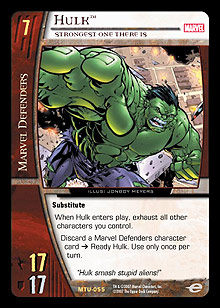
Hulk, Strongest One There Is is another 7-drop version of the character. This one joins Grumpy Green Goliath on the Marvel Defenders’ character roster. The Hulk was a founding member of the Marvel Defenders, as portrayed in Marvel Feature #1, published in December 1971. Almost a companion card for the plot twist One-Man Rampage, this card shows that once Hulk gets going, he’s very hard to stop. Few characters have an innate ability to attack twice in one turn, but the Hulk tends to build up so much momentum that he becomes a veritable wrecking ball. The flip side of this is that when he comes into play, he exhausts the rest of your characters. I like to think of this effect as all the other heroes on your team leaping to the rescue of the innocent bystanders who are endangered by the collateral damage the Hulk usually causes.

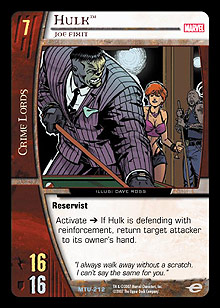
Hulk, Joe Fixit is yet another 7-drop from the Marvel Team-Up set, but this time it’s the Gray Hulk . . . and he plays for the Crime Lords! Actually, as muscle for hire, he works pretty well on any team that’s willing to invest a Team-Up on him. Remember that the Gray Hulk is the sneakiest and most cunning of all of the Hulks, and this card beautifully captures that. Joe Fixit appropriately has the smallest stats of all the 7-drop Hulks, but his power means that any characters attacking him could quickly find the rug pulled out from under them—and trying to team attack him is a recipe for disaster. I personally love this card, both from a flavor point of view and in terms of game play.
The Hulk cards that have appeared in Vs. System to date have done a remarkable job of capturing the flavor of the Hulk’s comic book personality and adventures. I hope one day to see versions of the character that pay homage to the Dr. Bruce Banner, Professor, and Maestro incarnations of the character, but I’m a patient man. Until that day, I’ll just be content to turn angry, green character cards sideways and yell “Hulk smash!” at my local Hobby League.
Finally, below is a recommended reading list to further your enjoyment of the Incredible Hulk’s adventures:
· Incredible Hulk Vol. 1 #1–6 and Tales to Astonish #60–91 (1963–1964) – Republished in Essential Incredible Hulk Vol. 1 TPB
· Incredible Hulk Vol. 1 #331–339 (1987–1988) – First Peter David writing, with Todd McFarlane art (republished in Hulk Visionaries: Peter David Vol. 1 TPB)
· Incredible Hulk Vol. 1 #340–348 (1988) – Gray Hulk and a special appearance of Wolverine (republished in Hulk Visionaries: Peter David Vol. 2 TPB)
· Incredible Hulk: Future Imperfect #1–2 (1992) – The Maestro
· Incredible Hulk #34–39 Vol. 2 (2002) – Republished in Incredible Hulk Vol. 1: Return of the Monster TPB
· Incredible Hulk #40–43 Vol. 2 (2002) – Republished in Incredible Hulk Vol. 2: Boiling Point TPB
· Incredible Hulk Vol. 2 #92–105 (2006–2007) – “Planet Hulk” (to be republished in Incredible Hulk: Planet Hulk TPB in June 2007)
· Hulk–Thing: Hard Knocks #1–4 (2004) – Republished in Hulk–Thing: Hard Knocks TPB
· Ultimates #1–12 (2002–2004) – Republished in Ultimates Vol. 1: Super Human and Ultimates Vol. 2: Homeland Security
See you in the funny pages,
Michael Pittman
ikeebear@hotmail.com